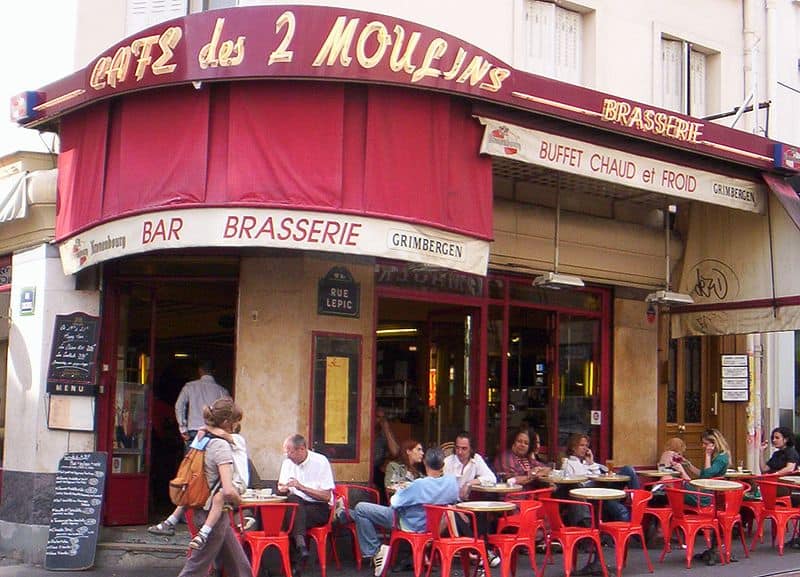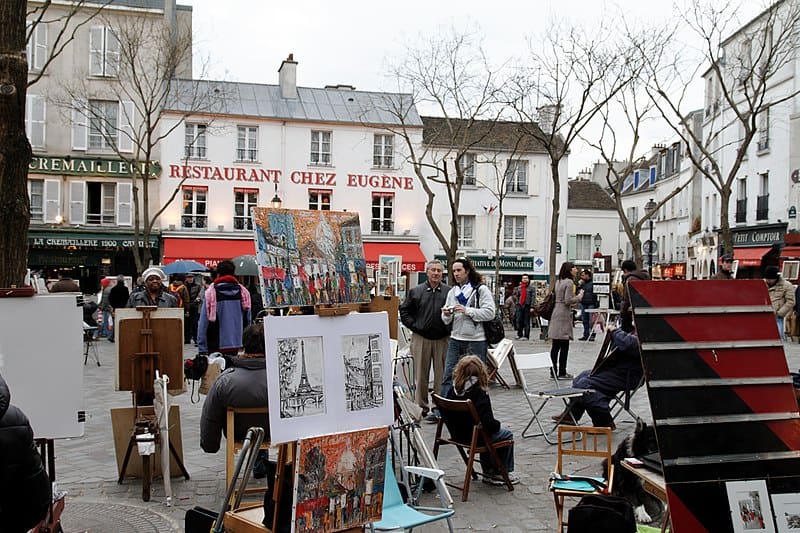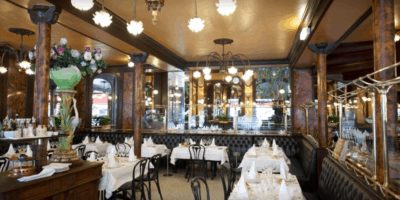Moulin Rouge to the Sacre Coeur: The Perfect Walking Route Through Montmartre (with a map)
Making your way up Montmartre hill by foot is the best way to see the village. You could save yourself the trouble of self navigating and join one of the free guided walking tours that take place through the neighborhood, it is entirely doable on one’s own.
The most logistically sound walking route begins at the foot of the mountain, outside the Moulin Rouge (purple marker). The route slowly inclines through the cobblestone streets, passing by all of the unmissable landmarks and attractions in this district before finally ending at the Sacre Coeur Church at the summit.
Doing the route as just a walking route will get you from start to finish in just under an hour. Properly experiencing the route, however, calls for a stop at each of the points along the way.
You’ll enjoy a full day out in Montmartre, meals included. Ready?
Start: Moulin Rouge in Montmartre
The Moulin Rouge sits on the main party strip of Pigalle at the foot of Montmartre hill. Here you’ll find bars and peepshows to your hearts content.
The historic and world famous cabaret is still in business over 150 years later. If you’re a fan of the film that came out in 2001, seeing the actual building in front of you is quite something. While the storyline of the Moulin Rouge movie may have been fictional, the venue and characters were all real.
Everyone who visits the Moulin Rouge after absorbing the worldwide propaganda has a different reaction. Some love it, others find it disappointing. A matter of perspective, I suppose.

The Moulin Rouge – by MarkusMark – Wikimedia Commons
Café des Deux Moulins in Montmartre
Moving on to another movie location just slightly north from here, the Café des Deux Moulins was featured in the French film that made waves around the world: Amélie.
If you’ve seen the film, you’ll recognize the cafe as the restaurant in which Amélie works her day job. There are various streets in Montmartre also used as scene locations for this film; it follows Amélie’s life in Paris.
The cafe is open for breakfast, lunch, dinner and even late night dining: between 7am and 1:30am, seven days a week.
Since we have a long walk and day ahead of us, stop in here to experience the energy of the place They hold their role in the film to high esteem, there are Amélie themed memorabilia on the walls as well as a salad named after her.

Le Café des deux Moulins – by Rcsmit – Wikimedia Commons
Tomb de Dalida in Montmartre
A short walk west from the cafe will take you into one of Montmartre’s main attractions… the cemetery.
Montmartre Cemetery is the third largest burial ground in Paris. It is also one of four garden cemeteries that were created in Paris in an attempt to make the city more sanitary and beautiful.
You’ll roam many many tombs here, amongst quite corners where you can settle with a book or a friend. Eventually near the bottom eastern end of the cemetery you’ll find the tomb of the famous French singer Dalida.
There is an incredible statue of the singer that rests on top of her grave; an angelic welcoming to the resting place.

Tomb of Dalida – by Yamen – Wikimedia Commons
The I Love You Wall in Montmartre
Next we take a long stroll east through Abbesses street, passing the theatre and metro station before we arrive at the next point.
The I Love You Wall in Montmartre is a 40ft wall panel that features the words “i love you” over 250 times in different languages and dialects from around the world. It is etched into tiles made of lava, making it virtually infallible to the outside world.
The piece is a commentary on the power of love and tolerance; a sign to remind one another to be just that. It could not have found a better home than in the city of love itself.
There are benches and a small children’s play area in the square that houses the mural. Place for a rest before you continue on your way.

I Love You Wall – by Nico Paix – Wikimedia Commons
Place du Tertre in Montmartre
Now the true incline begins…
Make your way between the winding streets from the I Love You Wall all the way up to the Place du Tertre. This is the village square of Montmartre, as well as the artist’s square to the rest of the world .
The Place du Tertre holds over 150 artists each day who are allowed to make and sell works from the square. Thousands of visitors come to this spot from around the world just to see the artists in action.
The square is lined with cafes, bars, restaurants and crêperies. In the early 1900s this was not so, and artists like Renoir, Monet and Picasso were often seen roaming the Place du Tertre or creating works from the benches.

Place du Tertre – by KimonBerlin – Wikimedia Commons
Le Moulin de la Galette in Montmartre
At a slight incline, next we head west. Le Moulin de la Galette is technically two landmarks under a single umbrella name.
These are the last two windmills remaining in Montmartre. At a time, there were over 300 windmills in Paris that were used in all sectors of industry.
Some will argue that the Moulin Rouge and a smaller windmill on a grave in the Montmartre Cemetery actually take the count of “Montmartre’s last windmills” to four.
The Moulin de la Galette (and the other two at that) are no longer in operation but are still open to be admired by the public. One is found on top of a cafe by the same name, and the other sits on private property but can be publicly viewed from the street.

Le Moulin Radet – by David McSpadden – Wikimedia Commons
Buste de Dalida in Montmartre
Montmartre holds the memory of Dalida near and dear to its heart. This is mostly because the singer called Montmartre home for the duration of her life in Paris.
Two blocks north of the Montmartre windmills is the Place Dalida, a small square that features yet another beautiful sculpture of her; made by the same artists who created the one on top of her tomb.
The Buste de Dalida, or bust of Dalida, is just that. A life-size statue of Dalida’s head and chest.
P.S. You’ve climbed as much as you’ll need to from here — the rest if all slightly downhill!

Buste de Dalida – by Ivonna Nowicka – Wikimedia Commons
La Maison Rose in Montmartre
We are now making a b-line for the Sacre Coeur with just two more attractions along the way.
The most famous cafe in Montmartre is la Maison Rose. You’ll recognize it by its bright pink exterior… and the many tourists taking photographs of it.
The cafe wasn’t always this high-key. During Montmartre’s artist days this was the frequent hangout spot for Pablo Picasso thanks to its quiet, private nature.
This is a great stopping point for a light lunch or tea before we enjoy two of the days main events.

La Maison Rose, Paris by Anyul Rivas – WikiCommons
Musée de Montmartre in Montmartre
The Montmartre Museum is a short walk from la Maison Rose. It’s a space that tells the story of Montmartre in a chronological, historically accurate way. On the same grounds we’ll also explore the Jardin’s Renoir and the Montmartre Vineyard.
Renoir lived inside of the Montmartre Museum during the two years he called Montmartre home. Here he created many works, some of them viewable inside the museum.
The gardens are named after him, as is the cafe. The gardens also give you the best view of the Montmartre Vineyard next-door; this is private property can only be viewed from the outside.

Montmatre Vineyard from the Montmartre Museum – by Shadowgate – Wikimedia Commons
The museum also houses the largest collection of Monet artworks known to be within a single space. The pieces were donated to the museum by his last known heir because, like every other artist in Paris, he so loved Montmartre and would have wanted his works to live on here.
Spend some time here, we only need to get to the Sacre Coeur around sunset for the best view over Paris!
End: Sacré-Cœur Basilica in Montmartre
If you’re still full of energy and want to see more landmarks, consider enhancing your city exploration with a comprehensive and enjoyable Paris walking tour.
After your afternoon in the museum and the gardens we can finally head to the final landmark on this self-guided walking tour.
The Sacre Coeur church is the crowning glory of Montmartre. The structure can be seen at the top of the hill from all over Paris.
It’s an exquisite building, and astoundingly one of the youngest churches in the whole country.
The Sacre Coeur attracts thousands of visitors daily. Because of its location so high up, the view from the outside of the church is phenomenal — hence why we needed to make it in time for sunset.

The Steps of the Basilica of Sacre Coeur – by Dietmar Rabich – Wikimedia Commons
A tour inside the church is worth it. The lower level is free to enter, you will only have to pay a small fee if you wish to climb up to the dome tower. This is worth doing, but at sunset hour it can become overly crowded and not worth the wait.
Enjoy the sunset from the steps outside instead while reflecting on the city below you and your journey up throughout the day.
Planning a trip to Paris ? Get ready !
These are Amazon’s best-selling travel products that you may need for coming to Paris.
Bookstore
- The best travel book : Rick Steves – Paris 2023 – Learn more here
- Fodor’s Paris 2024 – Learn more here
Travel Gear
- Venture Pal Lightweight Backpack – Learn more here
- Samsonite Winfield 2 28″ Luggage – Learn more here
- Swig Savvy’s Stainless Steel Insulated Water Bottle – Learn more here
Check Amazon’s best-seller list for the most popular travel accessories. We sometimes read this list just to find out what new travel products people are buying.














